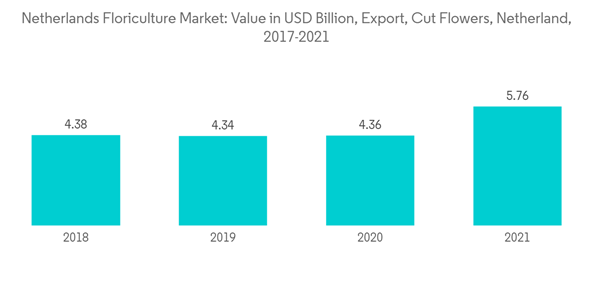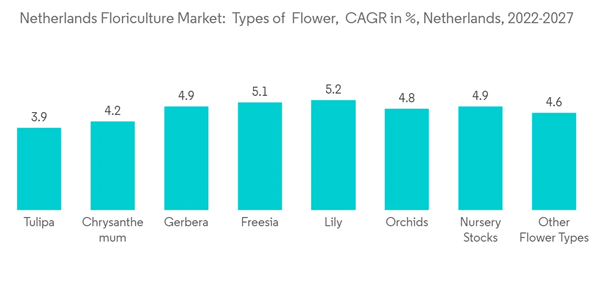The Netherlands Floriculture Market size is estimated at USD 4.89 billion in 2024, and is expected to reach USD 6.15 billion by 2029, growing at a CAGR of 4.70% during the forecast period (2024-2029).
This product will be delivered within 2 business days.
Key Highlights
- The Netherlands is a key producer of cut flowers and imports a considerable volume from underdeveloped countries. Floriculture is one of the most lucrative industries in the Netherlands. Spring is usually the busiest time of year at the Aalsmeer Flower Auction in the Netherlands, the world's blossom trade capital. Aside from being a global leader in cut flowers, the Netherlands is also a major commerce center.
- The Netherlands is Europe's flower market core due to its logistical position within Europe and established international trade relations within the flower business. It has a century of experience in the floral industry. Growers are supported by various services, including R&D and an efficient distribution infrastructure well connected by air and ground transportation to the most major producing and consuming countries. The vital function of auctions and well-developed infrastructure is the driving factor behind the industries.
- With the development of e-commerce platforms such as Fleurop, Flowers, and Euroflorist, with the ability to complete direct sales with consumers rather than utilizing an intermediary such as a wholesaler, the sales of cut flowers are expected to have a favorable impact on the Netherlands Floriculture Market. Due to the increased demand from peak days and the adoption of new technologies, cut flower production in the country is increasing, which is anticipated to boost the growth of the floriculture market during the forecast period.
Netherlands Floriculture Market Trends
Netherlands Importance for Trade Hub for Cut Flowers
- The Netherlands is the largest cut flower producer and a critical exporter to developing countries. Apart from being one of the market leaders for cut flowers, the Netherlands is also the central trade hub, especially in the area of Aalsmeer.
- The flower market in the Netherlands is a dynamic, fast-growing global industry defined by three major components, growers, wholesalers, and retailers. The Dutch flower auction, i.e., Royal Flora Holland, is Europe's main marketplace for cut flowers. Flowers worldwide find their buyers through this auction and the Dutch network of flower traders. It serves as an essential trade platform for traders from developing countries.
- The main export markets of floriculture are Germany, followed by the United Kingdom, France, Russian Federation, and Poland. According to the International Trade Center (ITC) trade map, in 2021, the Netherlands exported 680,090 metric tons of cut flowers valued at USD 5.7 billion. Thus, the increased demand for cut flowers globally is driving the export market in the Netherlands
Rose and Tulips are Dominating the Market
- Cut roses in the Netherlands vary in size (big and moderate Hybrid Tea roses and tiny Sweetheart roses), color (white through red and combinations), scent, and other characteristics. Across the country, some magnificent types are sold as solitary flowers. Of several rose varieties grown in the country, Red Naomi, Red Eagle, Pink Avalanche, and Avalanche plus are some of the most common.
- The demand for roses peaks on important days each year, such as Mother's day and Valentine's day. Several supermarkets and florists run special promotional campaigns such as Mother's day and offer special Valentine's day bouquets to increase their sales volume, which is anticipated to increase during the forecast period.
- The tulip is the second most prevalent flower. The weather in the country is considered ideal for growing tulips, with its long, cool springs and moist, well-drained soils. Every year, on National Tulip Day in January, Tulip season, extending from January-April, is officially inaugurated when Dutch tulip growers create a massive temporary garden filled with 200,000 tulips in front of the royal palace on Dam Square in Amsterdam.
Netherlands Floriculture Industry Overview
Additional Benefits:
- The market estimate (ME) sheet in Excel format
- 3 months of analyst support
This product will be delivered within 2 business days.
Table of Contents
1 INTRODUCTION
4 MARKET DYNAMICS
5 MARKET SEGMENTATION
6 VALUE CHAIN AND TRADE ANALYSIS
Methodology

LOADING...










